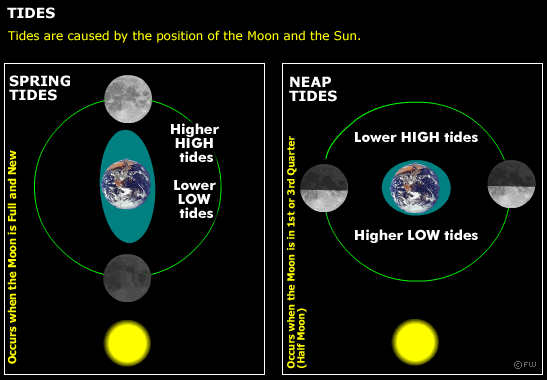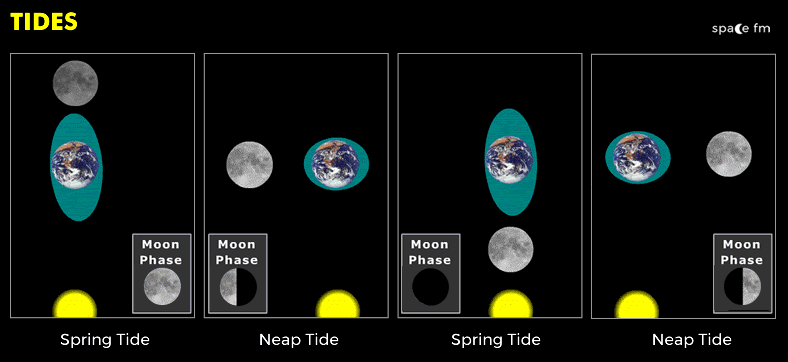Tides
3.5 - Understand the relative effects of the Sun and Moon in producing high and low, spring and neap tides4.9 - Understand the lunar phase cycle
The gravitational attraction of the Moon and Sun on pulls on Earth. The water on Earth's surface is pulled and the water causes tides.
Imagine if you were sat on a beach. You may notice the sea is a long way from the beach. This is low tide. Six hours later, you will find water surrounding you and lashing at your feet. This is high tide.
The Moon pulls water on Earth's surface nearest it and there is a force equal to this on the other side of the Earth.
Tides change at every position on Earth for three reasons:
- The Moon is orbiting Earth
- Earth rotates and water is attracted to and from the Moon.
- The Sun exerts a tidal force on Earth that is approximately 40% that of the Moon.
When the Sun, Moon and Earth are in line (typically during a New and Full Moon) there are more dramatic differences in tides. High tides are higher and low tides are lower.
These tides are called spring tides (From the Anglo Saxon word meaning 'leap'). They are not connected to the spring season.
When the Sun, Moon and Earth are not in line - when the Moon is at right angles (or quadrature) to Earth then the tides are less dramatic. High tides are lower than at other times. Low Tides are higher than at other times.
These tides are called neap (From the Anglo Saxon word meaning 'scanty')
Tides are not the same over the world as a lot depends on the depth of sea, channels, shape of land masses and continents etc.
Summary
| Type | Feature | Timing |
|---|---|---|
| Spring Tides |
Higher HIGH tides Lower LOW tides |
Full & New |
| Neap Tides | Lower HIGH tides Higher LOW tides |
First & Third Quarters |
Did you know?
- The Bay of Fundy in Canada has the largest tidal difference in the world followed by the Severn Channel between England and Wales.
- If the Moon had seas and oceans the tides would be even more dramatic than on earth because the pull of Earth would be much greater.
- The tides influence Earth's rate of rotation as they act as a brake slowing it down slightly
Links
- NOAA SciJinks What causes tides
- Teach the Earth Visualizations Useful for Teaching Tides
- Tides. Info Tide Predictor
- Enchanted Learning Why tides take place
- National Geographic Tide Encyclopedic entry / Resources



 | © All Rights Reserved |
| © All Rights Reserved |